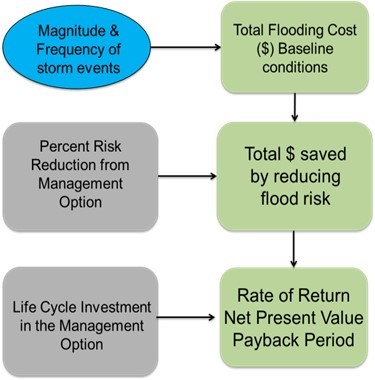Risk and Return on Investment Tool (RROIT Version 1.0)
 Trends in Canada and Ontario with respect to weather-related risk show increases in damages borne by property owners and municipal governments with respect to extreme rainfall and flooding events,[1] as well as increased frequency of legal action being taken against municipalities to recoup damages considered to have resulted from non-resilient infrastructure[2]. Predictive climate change modelling technology is becoming more advanced, and is being used on an increasing basis to estimate increased risk due to changes in climate patterns, such as more frequent extreme rainfall events; however, a gap remains in understanding the full financial implication of these events.
Trends in Canada and Ontario with respect to weather-related risk show increases in damages borne by property owners and municipal governments with respect to extreme rainfall and flooding events,[1] as well as increased frequency of legal action being taken against municipalities to recoup damages considered to have resulted from non-resilient infrastructure[2]. Predictive climate change modelling technology is becoming more advanced, and is being used on an increasing basis to estimate increased risk due to changes in climate patterns, such as more frequent extreme rainfall events; however, a gap remains in understanding the full financial implication of these events.
National Disaster Mitigation Program Stream 3, Disaster Mitigation Action Fund (DMAF) and Infrastructure Canada’s Climate Change Lens require climate change risk assessments and return on investment analyses as prerequisites for infrastructure funding. With support through the National Disaster Mitigation Program, Credit Valley Conservation Authority and partners are developing a Risk and Return on Investment Tool for water infrastructure to assist municipalities and conservation authorities to make evidence-based, cost-effective decisions to reduce flood risk and meet funding requirements.
The tool will perform the following key functions:
- Regional climate change projections
- Assess baseline flood & erosion risks associated with extreme rainfall events, and quantify the potential damages to private and public infrastructure, and vulnerable populations under current and future climate
- Evaluate and compare risk-reduction achievable by management options (e.g. grey and green stormwater infrastructure, land acquisition, flood proofing etc.)
- Perform a financial assessment of the return on investment associated with each or combination of management options by comparing life cycle costs to the benefits (i.e.: cost savings) achieved by reducing flood risk under various climate change scenarios
- Identification of high risk areas that considers social, health, infrastructure and environmental vulnerabilities
The Tool will include a user-friendly, web-based interface, which will prompt the user for data regarding the relationships that exist for their specific water infrastructure systems, while also providing pre-programmed relationships and data from similarly-situated municipalities. See Sample Tool output results.
If you are interested in learning more about the RROIT or would like to participate as a case study, please contact:
Christine Zimmer at Christine.zimmer@cvc.ca
Amanjot Singh at Amanjot.singh@cvc.ca
[1] Review of the Facts of the Property and Casualty Insurance Industry in Canada 2016 report indicates that catastrophic losses due to extreme rainfall events have increased dramatically over the last two decades. Reference: http://assets.ibc.ca/Documents/Facts%20Book/Facts_Book/2016/Facts-Book-2016.pdf
[2] As stated in a report by zizzoallan Professional Corporation, a growing number of lawsuits against municipalities in Canada are being brought forward in the form of class actions, as a result of failure to mitigate risks and prevent damage from flooding. Cases like this deal with systemic stormwater planning concerns, which are likely to increase in light of climate change. Reference: http://www.creditvalleyca.ca/wp-content/uploads/2014/05/Stormwater-Management-in-Ontario_Legal-Issues-in-a-Changing-Climate_2014.04.29.pdf
